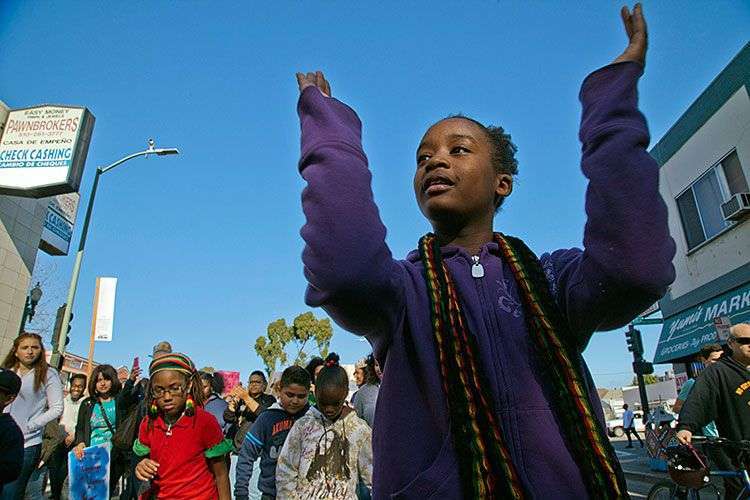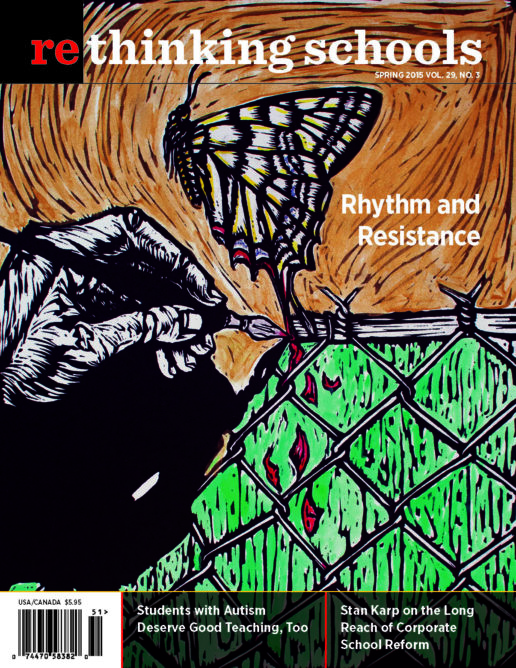Black Students’ Lives Matter
Building the school to justice pipeline

We’re at a tipping point. The killings of Trayvon Martin, Jordan Davis, Mike Brown, Tamir Rice, Renisha McBride—and far too many other African Americans—have put to rest the myth of a “post-racial” America. In death, these Black youth—shot down with impunity because of the color of their skin—have provided a tragically thorough education about police terror and institutional racism, and ignited the Black Lives Matter movement.
The hashtag #BlackLivesMatter was originally created by queer Black women activists Alicia Garza, Patrisse Cullors, and Opal Tometi as a call to action after George Zimmerman was acquitted of the murder of Trayvon Martin in July 2013. Their battle cry went viral and then turned into a national uprising when Darren Wilson, a police officer in Ferguson, Missouri, killed Michael Brown, an unarmed Black teenager. The movement exploded when Staten Island police officer Daniel Pantaleo was not indicted for choking to death Eric Garner.
As the Black Lives Matter movement has grown, Black students have played a pivotal role. For example, at Seattle’s Garfield High School, some 1,000 students, led by the Black Student Union (BSU), walked out the day after the non-indictment of Wilson was announced. As 17-year-old Issa George, vice president of the Garfield BSU, told the Seattle Times: “This is our time, as youth, to speak. . . . The waking up that America has done in the past couple of months—something that us as youth get to witness and get to be a part of—has been extremely powerful.”
College, high school, and even middle school students have staged protests and school walkouts in cities around the country. According to reporting by the Nation‘s George Joseph and others, student activists of the Baltimore Algebra Project held a die-in when their local school board voted to shut down the first of five schools. The board fled, and the students took over their chairs to lead a community forum on the closures.
Black students take these risks because they know their lives and futures are at stake—from police violence on the street; from the dismantling of their communities through foreclosures, gentrification, and unemployment; and from the destruction of their schools through corporate reform.
The School-to-Grave Pipeline
For the past decade, social justice educators have decried the school-to-prison pipeline: a series of interlocking policies—whitewashed, often scripted curriculum that neglects the contributions and struggles of people of color; zero tolerance and racist suspension and expulsion policies; and high-stakes tests—that funnel kids from the classroom to the cellblock. But, with the recent high-profile deaths of young African Americans, a “school-to-grave pipeline” is coming into focus. Mike Brown had just graduated from high school and was preparing to go to college when police killed him. According to a 2012 investigation by the Malcolm X Grassroots Movement, a Black person is killed by law enforcement, security guards, or vigilantes every 28 hours. A recent ProPublica report found that “Blacks, age 15 to 19, were killed at a rate of 31.17 per million, while just 1.47 per million white males in that age range died at the hands of police.”
The Black Lives Matter movement inspires us to fight the school-to-grave pipeline as an example of structural racism, after decades in which anti-racism has been defined in excessively personal terms through anti-bias or diversity training. Anti-bias work focuses primarily, and often exclusively, on internal and interpersonal racism. In other words, if you strive to not be racist in your personal relationships, that’s good enough.
There is definitely a place for personal reflection and discussion of racist attitudes and beliefs. And there is no doubt that many individual police officers need anti-bias training and to be held responsible for their actions. But that’s not enough, as the statistics on police violence, incarceration, school suspension and dropout rates, inequitable school financing, and school closures make clear. These are all sharp indicators of structural racism. When Michelle Alexander says mass incarceration is “the new Jim Crow,” she insists that the racist structures that have existed since slavery have mutated and changed, but they have not been eradicated. We can’t understand, teach about, or change what’s happening in this country if we don’t face this fact. And our students know that. Being an effective teacher in today’s society means taking the Black Lives Matter movement seriously.
For all the “students first” rhetoric of the corporate education reformers—who claim their policies are directed at closing the “achievement gap”—they are conspicuously absent from the Black Lives Matter movement. In fact, the corporate reform agenda is in direct conflict with the goals of the movement. In city after city, Black students are those most affected by the decimation of neighborhood schools, the “no excuses” discipline and rote teaching of charters like KIPP, the substitution of endless test prep for meaningful curriculum, and the imposition of two-years-and-I’m-gone Teach For America corps members on our highest needs students.
Black Lives Matter doesn’t just mean Black people don’t want to be shot down in the streets by unaccountable police. As anti-racist teachers and students, we need to expand the slogan to include:
- Stop closing schools in Black neighborhoods.
- Fund schools equitably.
- Support African American studies programs and substantive multicultural curriculum.
When activists staged a Black Lives Matter die-in in Detroit last December, Will Daniels, from United Students Against Sweatshops, told the Nation: “As a Black student, my rationale for doing the die-in was that structural racism causes not only police brutality, but also the starving of majority Black schools. This is a subtler form of violence.”
Let Black Children Be Children
The murder of Tamir Rice exposes a connection between individual racism and structural racism with important implications for teachers. Tamir was only 12 years old when police showed up at the Cleveland park where he was playing with a toy gun and shot him down within two seconds of their arrival. When his 14-year-old sister ran over, she was tackled to the ground and handcuffed. The officer who called in the shooting described Tamir to the dispatcher as a “Black male, maybe 20.”
Overestimating the age, size, and culpability of Black children is a widespread phenomenon, according to The Essence of Innocence: Consequences of Dehumanizing Black Children, based on research led by Phillip Atiba Goff and Matthew Christian Jackson of UCLA. One of their studies involved 264 mostly white female undergraduates who were asked to assess the age and innocence of white, Black, and Latino boys. The students saw the Black boys as more culpable and overestimated their age by 4.5 years. “Perceptions of the essential nature of children can be affected by race and, for Black children, this can mean they lose the protection afforded by assumed childhood innocence well before they become adults,” said Jackson. “Black children may be viewed as adults when they’re just 13 years old.”
It’s not much of a stretch to see how this affects Black children in schools where the majority of their teachers are not African American. Any time teachers or administrators see Black children as older than they are, “just being teenagers” (or pre-teens, or little kids) becomes something threatening that has to be controlled or disciplined. How can children grow and learn if the adults around them see them as older and “guiltier” than they are? What will it take for school communities to eradicate this deeply embedded prejudice?
Why Not “All Lives Matter?”
As the Black Lives Matter movement has grown, some participants have questioned whether “All Lives Matter” is a more inclusive slogan. Although we recognize the serious impact of racism and other forms of oppression on many groups of people in the United States, we think it’s important to understand and talk with others about the historical and current realities behind this specific demand. As Alicia Garza, one of the movement’s originators, explains:
When we say Black Lives Matter, we are talking about the ways in which Black people are deprived of our basic human rights and dignity. . . . It is an acknowledgment that one million Black people are locked in cages in this country. . . . It is an acknowledgment that Black women continue to bear the burden of a relentless assault on our children and our families. . . . #BlackLivesMatter doesn’t mean your life isn’t important—it means that Black lives, which are seen as without value within White supremacy, are important to your liberation. Given the disproportionate impact state violence has on Black lives, we understand that when Black people in this country get free, the benefits will be wide-reaching and transformative for society as a whole.
A civil disobedience demonstration that closed down the federal building in Oakland during Martin Luther King Jr. weekend highlighted the connections. Behind a banner reading “Third World for Black Power,” protesters identified themselves as Arabs, Filipinas/os, Latinas/os, Koreans, Chinese, Palestinians, and South Asians “for Black resistance.” As Filipina activist Rhonda Ramiro said: “The wealth accumulated through the enslavement of Black people in the United States enabled the United States to go around the world and colonize countries like the Philippines. We see our struggle for independence as linked 100 percent.”
Within that framework, how teachers apply this understanding will obviously vary from classroom to classroom, depending on how old the children are, their experience and knowledge about the issues involved, and the level of community that has been built in the classroom.
How to Make Black Lives Matter in Our Schools
So what does all this mean in individual classrooms and schools? Here are a few ideas for bringing Black Lives Matter into our teaching:
- Provide a social justice, anti-racist curriculum that gives students the historical grounding, literacy skills, and space to explore the emotional intensity of feelings around the murder of Black youth by police. At the same time, deep discussion of these heavy issues needs to build on strong classroom community. Students can’t launch into discussions of racism without a basis of trust and sharing among students and between students and teacher. That is the slow, steady work of meaningful classroom conversation, purposeful group work, reading and writing about critical social and personal issues, shared writing, and more. Teachers need to nurture communities of mutual respect and empathy.
- Support students who want to have conversations about the Black Lives Matter movement outside the classroom, in school forums or school clubs. Educators supporting the work of BSUs in schools across the country have helped transform the school climate. Black students’ sense of pride and self-worth have helped ignite this new civil rights movement.
- Raise the Black Lives Matter movement with other teachers at our schools and in our unions. It’s not enough to provide students with historical lessons. History is being made today by teachers planning Black Student Lives Matter forums and die-ins, advocating for hiring more Black teachers, and participating in many other actions around the country.
This is the moment social justice educators have been waiting for. When pro football players ran onto the field with their hands up in a demonstration of solidarity with the “Hands Up, Don’t Shoot” protests that followed Michael Brown’s murder, some people in the audience supported them; others were opposed. But everyone knew what they meant. This is a sea change. The topic of police violence against Black people and systemic racism is on the table in a way it hasn’t been for a generation. It’s time to put aside the test prep and build a school-to-justice pipeline.

